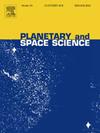月海Ingenii:一项全面的多数据研究,揭示了成分、年代学和地形动力学
IF 1.7
4区 物理与天体物理
Q3 ASTRONOMY & ASTROPHYSICS
引用次数: 0
摘要
利用不同的轨道遥感数据对位于南极-艾特肯盆地西北部的撞击盆地Mare Ingenii的成分、年代、地形和形态特征进行了分析。研究化学特征、光谱特征、年龄和表面特征有助于阐明盆地的形成过程和火山演化。本研究利用月船1号月球矿物学成像仪(Ch-1 M3)数据制备标准波段比(SBR)、光学成熟度(OMAT)、1000 nm和2000 nm综合波段深度(IBD)彩色合成图像,绘制盆地不同岩性和基性特征。利用月船2号成像红外光谱仪(Ch-2 IIRS)数据推导了1000 nm和2000 nm的IBD,并用M3衍生图像对结果进行了验证。矿物如橄榄石、辉石、斜长石、尖晶石和钛铁矿是通过光谱研究识别和验证的。利用Kaguya的FeO wt.%图和LROC WAC (Lunar Reconnaissance Orbiter Camera - Wide Angle Camera)的tio_2图获得FeO和tio_2丰度。然后将这些丰度与M3数据得出的丰度进行比较,以验证成分分析。本研究利用TiO2、FeO和IBD颜色合成图的变化确定了Ingenii盆地的19个mare单元。利用陨石坑尺寸-频率分布(CSFD)技术得到了每个单元的年龄,其范围在3.8 ~ 2.3 Ga之间,与前人的研究结果具有较好的相关性。因此,很明显,英吉尼海受到了长时间的海火山活动的影响,同时也受到了一些已被确定的非海玄武岩表面的影响,包括与里脊有关的熔岩流和O'Day撞击融化板。盆地主要受寒武纪低至极低钛玄武岩淹水,在埃拉托色尼纪出现过中低钛玄武岩侵位。利用月球轨道激光高度计(LOLA)数据圈定了盆地的地形,并绘制了600 km的外环。利用Kaguya Terrain Camera (TC)和LROC数据识别出了河纹、褶皱脊、地堑、漩涡、O'Day撞击熔体和v形特征等形态特征,这些特征有助于了解该盆地过去的火山和陨石坑过程。结果表明,英吉海具有较长的火山历史,以低至极低钛玄武岩为主,主要来源于橄榄石-钛铁矿-辉石堆积。本文章由计算机程序翻译,如有差异,请以英文原文为准。
Lunar Mare Ingenii: A comprehensive multi data study unravelling composition, chronology and terrain dynamics
The compositional, chronological, topographical, and morphological features of Mare Ingenii, an impact basin situated in the northwest part of the South Pole-Aitken basin (SPA) are cha racterized using different orbital remote sensing data. Examining the chemical characteristics, spectral signatures, age, and surface features help to elucidate the basin's formation process and its volcanic evolution. In the present study, Chandrayaan-1 Moon Minerology Mapper (Ch-1 M3) data is used to prepare Standard Band Ratio (SBR), Optical Maturity (OMAT), 1000 and 2000 nm Integrated Band Depth (IBD) color composite images to map different lithologies and mafic signatures of the basin. Chandrayaan-2 Imaging Infrared Spectrometer (Ch-2 IIRS) data is used to derive 1000 and 2000 nm IBD and result is validated with M3 derived images. Minerals like olivine, pyroxene, plagioclase, spinel, and ilmenite are identified and validated through spectral studies. The FeO wt.% map from Kaguya and the TiO₂ map from the Lunar Reconnaissance Orbiter Camera - Wide Angle Camera (LROC WAC) were used to obtain FeO and TiO₂ abundances. These were then compared with abundances derived from M3 data to validate the compositional analysis. The present study identified 19 mare units in the Ingenii basin using variations in TiO2, FeO, and IBD color composite maps. Crater Size-Frequency Distribution (CSFD) technique has been employed to obtain the age of each unit and it ranges from 3.8 to 2.3 Ga and the results well correlated with previous studies. It is thus evident that Mare Ingenii has been affected by a prolonged period of mare volcanism along with a few non-mare basaltic surfaces that have been identified, including rille-related lava flows and O'Day impact melt sheets. The basin was flooded mainly by low to very low Ti basalts of the Imbrian period and patches of intermediate Ti basaltic emplacement happened during the Eratosthenian period. The topography of the basin is delineated by using Lunar Orbiter Laser Altimeter (LOLA) data and an outer ring of 600 km is mapped in this study. Morphological features such as rille, wrinkle ridge, graben, swirls, O'Day impact melt, and V-shaped features are identified using Kaguya Terrain Camera (TC) and LROC data which can offer understanding into the basin's past volcanic and cratering process. The results suggest that Mare Ingenii possesses a prolonged volcanic history and the mare is dominated by low to very low Ti basalts sourced from olivine-ilmenite-pyroxene cumulates.
求助全文
通过发布文献求助,成功后即可免费获取论文全文。
去求助
来源期刊

Planetary and Space Science
地学天文-天文与天体物理
CiteScore
5.40
自引率
4.20%
发文量
126
审稿时长
15 weeks
期刊介绍:
Planetary and Space Science publishes original articles as well as short communications (letters). Ground-based and space-borne instrumentation and laboratory simulation of solar system processes are included. The following fields of planetary and solar system research are covered:
• Celestial mechanics, including dynamical evolution of the solar system, gravitational captures and resonances, relativistic effects, tracking and dynamics
• Cosmochemistry and origin, including all aspects of the formation and initial physical and chemical evolution of the solar system
• Terrestrial planets and satellites, including the physics of the interiors, geology and morphology of the surfaces, tectonics, mineralogy and dating
• Outer planets and satellites, including formation and evolution, remote sensing at all wavelengths and in situ measurements
• Planetary atmospheres, including formation and evolution, circulation and meteorology, boundary layers, remote sensing and laboratory simulation
• Planetary magnetospheres and ionospheres, including origin of magnetic fields, magnetospheric plasma and radiation belts, and their interaction with the sun, the solar wind and satellites
• Small bodies, dust and rings, including asteroids, comets and zodiacal light and their interaction with the solar radiation and the solar wind
• Exobiology, including origin of life, detection of planetary ecosystems and pre-biological phenomena in the solar system and laboratory simulations
• Extrasolar systems, including the detection and/or the detectability of exoplanets and planetary systems, their formation and evolution, the physical and chemical properties of the exoplanets
• History of planetary and space research
 求助内容:
求助内容: 应助结果提醒方式:
应助结果提醒方式:


